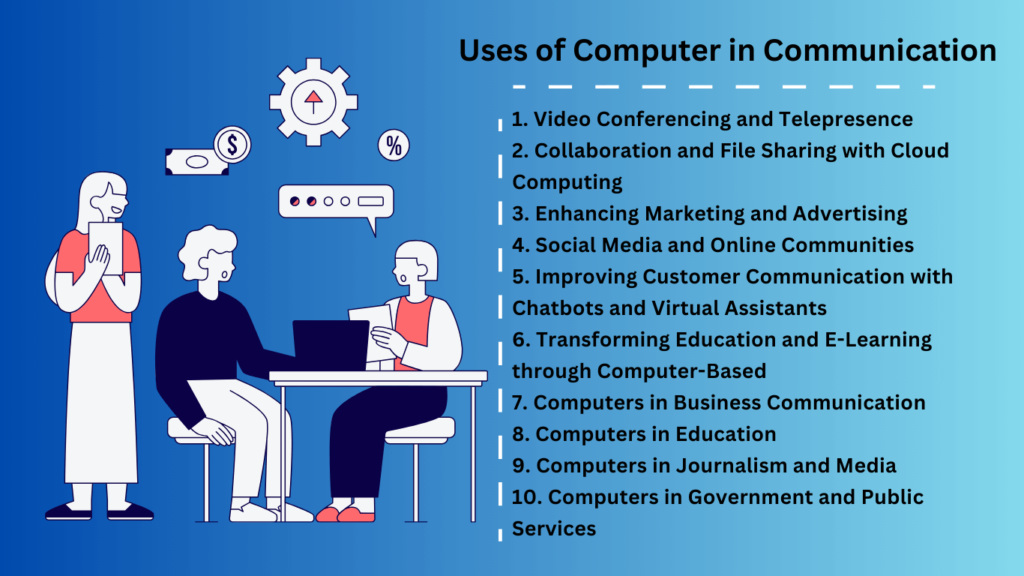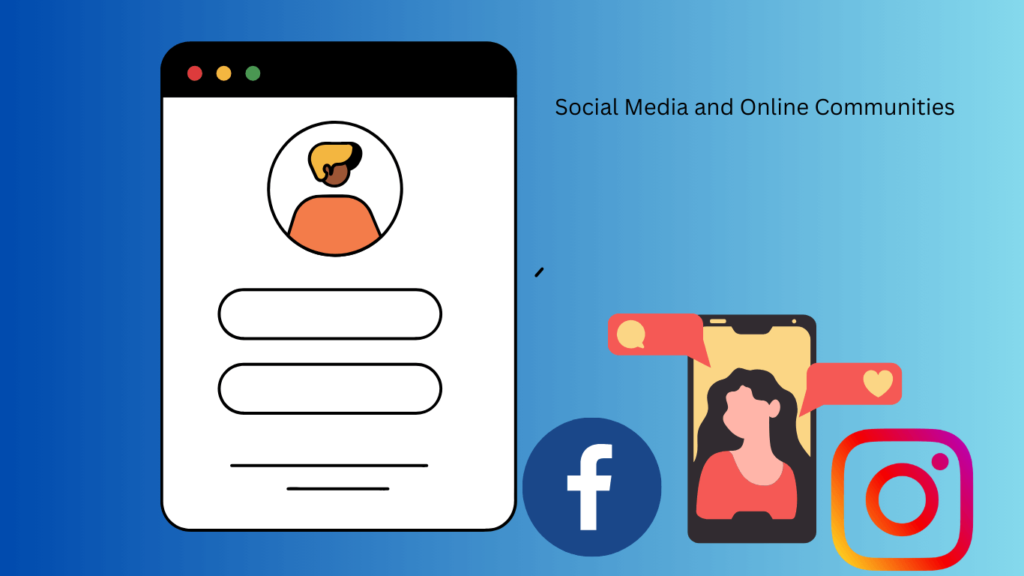Uses of Computer in Communication: In today’s fast-paced digital world, computers have become an integral part of our lives, revolutionizing the way we communicate. One of the most widely used applications of computers in communication is through email and instant messaging.

With just a few clicks, we can send messages to anyone across the globe, bridging the gap between distance and time zones. Email has become the backbone of professional communication, allowing us to send detailed messages, documents, and files instantly.
Use of Computer in Communication | Uses of Computer in Communication
Table of Contents
1. Video Conferencing and Telepresence
Video conferencing platforms like Zoom and Skype enable participants to see and hear each other in real time, fostering a sense of presence and engagement. This technology has not only saved time and money spent on travel but has also opened up opportunities for remote work and global collaborations.
With the help of virtual reality and advanced robotics, individuals can feel as if they are physically present in a different location. Telepresence takes video conferencing to the next level, providing a more immersive experience.
2. Collaboration and File Sharing with Cloud Computing
The advent of cloud computing has transformed the way we collaborate and share files. Instead of relying on physical storage devices like USB drives or external hard disks, we can now store our data securely in the cloud, accessible from any computer with an internet connection.
Cloud storage services like Google Drive, Dropbox, and OneDrive have become essential tools for businesses and individuals alike. They allow multiple users to collaborate on documents in real time, making teamwork more efficient.
3. Enhancing Marketing and Advertising
Digital communication channels have opened up new avenues for businesses to reach and engage with their target audience. One of the key uses of computers in marketing is through targeted advertising. With the help of data analytics and machine learning algorithms, businesses can identify and target specific demographics with personalized ads.
Social media platforms have also become powerful tools for marketing and advertising. Businesses can create and manage their online presence through platforms like Facebook, Instagram, and Twitter. They can engage with their audience, build brand awareness, and even generate leads through targeted social media campaigns.
4. Social Media and Online Communities
Social media and online communities have become an integral part of our daily lives, and computers have played a pivotal role in their evolution. These platforms have transformed the way we connect, share information, and engage with others.
Computers have made it possible for us to access social media platforms anytime, anywhere. Whether it’s Facebook, Twitter, or Instagram, we can stay connected with friends, family, and colleagues with just a few clicks. Social media has become a powerful tool for communication, allowing us to share our thoughts, experiences, and photos instantly.

Online communities have also flourished with the help of computers. Platforms like Reddit, Quora, and Stack Exchange have created spaces where people with similar interests can connect and share knowledge. These communities have become valuable resources for learning, collaboration, and support.
5. Improving Customer Communication with Chatbots and Virtual Assistants
In the digital age, businesses are constantly looking for ways to improve customer communication and provide better support. Computers have introduced chatbots and virtual assistants, which have revolutionized the customer service industry.
Chatbots are computer programs that simulate human conversation and provide automated responses to customer queries. They can handle a wide range of customer service tasks, such as answering frequently asked questions, providing product recommendations, and even processing orders. Chatbots are available 24/7, ensuring prompt and consistent customer support.
Virtual assistants, on the other hand, take customer communication to the next level. Powered by artificial intelligence, virtual assistants like Siri, Alexa, and Google Assistant can understand natural language and perform tasks on behalf of the user. They can schedule appointments, set reminders, make phone calls, and even control smart home devices.
6. Transforming Education and E-Learning through Computer-Based
E-learning platforms and virtual classrooms have made education more accessible, flexible, and interactive. Online learning platforms like Coursera, Udemy, and Khan Academy offer a wide range of courses and educational resources to learners around the world.
Virtual classrooms have brought the traditional classroom experience into the digital realm. With video conferencing and collaboration tools, teachers can conduct live classes, engage with students, and facilitate discussions.
Virtual classrooms have enabled education to continue even during times of crisis, ensuring that students can access quality education regardless of their physical location. Multimedia presentations, interactive simulations, and virtual reality experiences have enhanced the learning experience, making complex concepts easier to grasp.
7. Computers in Business Communication
Computers have revolutionized business communication through collaboration tools and virtual meetings, enabling teams to work together seamlessly, regardless of their physical location. Collaboration tools like Microsoft Teams, Slack, and Trello have become essential for businesses of all sizes.
These tools allow team members to communicate, share files, and manage projects in one centralized platform. They streamline workflows and improve productivity by providing a single source of truth for all team-related activities.
Virtual meetings have become the norm, especially with the rise of remote work. With the help of video conferencing platforms, teams can connect face-to-face, discuss ideas, and make important decisions. Virtual meetings have eliminated the need for travel, saving time and reducing costs.
8. Computers in Education
Computers have transformed the field of education, making learning more accessible, engaging, and personalized. Online learning platforms and virtual classrooms have revolutionized the way students learn and teachers teach.
Online learning platforms provide a wide range of courses and educational resources, covering various subjects and skill levels. Students can access these platforms anytime, anywhere, and learn at their own pace. Virtual classrooms bring the traditional classroom experience into the digital realm.
9. Computers in Journalism and Media
Computers have revolutionized the field of journalism and media, transforming the way news is created, disseminated, and consumed. Digital publishing and online news platforms have become the new norm, providing instant access to news and information.

Digital publishing has made it easier for journalists and content creators to publish and distribute their work. With the help of computers, news articles, blogs, and multimedia content can be created, edited, and shared in real time. This has accelerated the news cycle, ensuring that the latest information reaches the audience as soon as possible.
10. Computers in Government and Public Services
Computers have transformed the way governments and public services communicate and interact with citizens. E-government and online services have made government information and services more accessible, efficient, and transparent.
E-government refers to the use of computers and digital communication technologies to deliver government services to citizens. From filing taxes to applying for permits and licenses, citizens can access government services online, saving time and reducing bureaucracy. E-government platforms have also facilitated the exchange of information between government agencies, improving coordination and decision-making.
So that’s all about “Uses of Computer in Communication”.